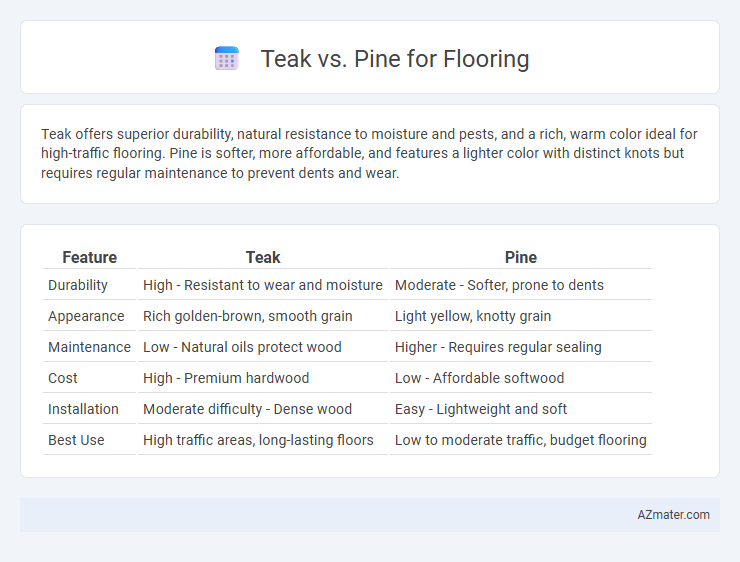Teak offers superior durability, natural resistance to moisture and pests, and a rich, warm color ideal for high-traffic flooring. Pine is softer, more affordable, and features a lighter color with distinct knots but requires regular maintenance to prevent dents and wear.
Table of Comparison
| Feature | Teak | Pine |
|---|---|---|
| Durability | High - Resistant to wear and moisture | Moderate - Softer, prone to dents |
| Appearance | Rich golden-brown, smooth grain | Light yellow, knotty grain |
| Maintenance | Low - Natural oils protect wood | Higher - Requires regular sealing |
| Cost | High - Premium hardwood | Low - Affordable softwood |
| Installation | Moderate difficulty - Dense wood | Easy - Lightweight and soft |
| Best Use | High traffic areas, long-lasting floors | Low to moderate traffic, budget flooring |
Introduction to Teak vs Pine Flooring
Teak flooring offers exceptional durability and natural resistance to moisture and pests, making it ideal for high-traffic areas and humid environments. Pine flooring, known for its warm tones and affordability, provides a softer surface that can develop a charming patina over time. Choosing between teak and pine depends on factors like budget, desired aesthetic, and maintenance preferences.
Physical Properties: Teak vs Pine
Teak flooring boasts exceptional durability, natural oils that resist moisture, and high hardness with a Janka rating of approximately 1155, making it ideal for high-traffic areas. Pine flooring, with a lower Janka hardness around 420, is softer and more prone to dents and scratches, yet offers a lighter, more rustic appearance. Teak's superior dimensional stability reduces warping and swelling, while pine requires more maintenance to handle moisture and wear over time.
Durability and Longevity Comparison
Teak flooring offers exceptional durability due to its dense grain and natural oils, making it highly resistant to moisture, insects, and wear, which significantly extends its lifespan beyond 50 years with proper care. Pine, being a softwood, is more susceptible to dents, scratches, and moisture damage, resulting in a shorter lifespan typically around 10-25 years under similar conditions. The superior hardness and natural resilience of teak make it a preferred choice for long-lasting, low-maintenance flooring solutions.
Aesthetic Appeal and Color Variation
Teak flooring showcases a rich, golden-brown hue with natural oils that enhance its warm, luxurious appearance, while pine offers a lighter, more rustic charm with knots and grain patterns that create a casual, inviting ambiance. Teak's consistent color deepens over time, contributing to its elegant and timeless appeal, whereas pine's color variation ranges from pale yellow to reddish tones, adding character through its natural imperfections. Both woods provide distinctive aesthetics, with teak favored for high-end, sophisticated spaces and pine chosen for cozy, country-style interiors.
Maintenance and Care Requirements
Teak flooring boasts natural oils that provide exceptional resistance to moisture, insects, and wear, resulting in lower maintenance requirements compared to pine, which is softer and more prone to dents and scratches. Pine flooring demands regular sealing and refinishing to protect against moisture damage and maintain its appearance. Proper care of teak includes occasional cleaning with mild soap and oil treatments to preserve its rich color and durability, whereas pine requires more frequent attention to avoid discoloration and surface damage.
Environmental Impact and Sustainability
Teak flooring offers superior durability and natural resistance to pests, reducing the need for chemical treatments, but its slow growth and high demand raise concerns about deforestation and illegal logging. Pine grows rapidly and is often sourced from sustainably managed plantations, making it a more renewable option with a lower carbon footprint. Choosing FSC-certified teak or pine ensures sustainable harvesting, helping minimize environmental impact while supporting responsible forestry practices.
Cost Analysis: Teak vs Pine Flooring
Teak flooring commands a higher price due to its natural durability, resistance to moisture, and rich grain patterns, typically costing between $5 to $12 per square foot, whereas pine flooring ranges from $3 to $7 per square foot, making it a more budget-friendly option. Long-term maintenance expenses for teak are typically lower, as its dense hardwood composition reduces the need for frequent treatments, while pine often requires more frequent refinishing and sealing to maintain its appearance and durability. Cost analysis shows teak offers better value in high-traffic areas due to its longevity despite higher upfront costs, whereas pine is suited for low-traffic spaces where initial savings take precedence.
Installation Process and Considerations
Teak flooring requires careful acclimation due to its dense hardwood nature, often needing professional installation to handle its weight and potential for expansion. Pine, being softer and lighter, is easier to install with common tools and suits DIY projects but may need extra attention to moisture control to prevent warping. Both materials demand proper subfloor preparation and acclimatization to ensure long-term durability and optimal fit.
Best Use Cases for Each Wood Type
Teak flooring excels in high-moisture areas such as bathrooms and kitchens due to its natural oil content and superior water resistance. Pine flooring is ideal for living rooms and bedrooms, offering a warm aesthetic and softer surface that is easier to repair and refinish. Both woods provide durability, but teak is preferred for outdoor or high-traffic spaces, while pine suits budget-friendly and rustic interior settings.
Final Verdict: Choosing the Right Flooring
Teak flooring offers exceptional durability, natural resistance to moisture, and a rich, warm aesthetic, making it ideal for high-traffic or humid areas. Pine flooring provides an affordable, softer option with a lighter appearance but requires more maintenance due to its susceptibility to dents and moisture damage. Choose teak for long-term investment and resilience, while pine suits budget-conscious projects prioritizing a classic, rustic look.

Infographic: Teak vs Pine for Flooring
 azmater.com
azmater.com